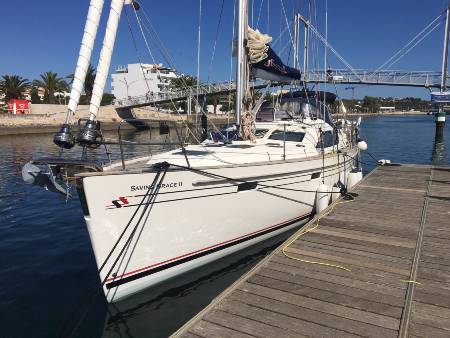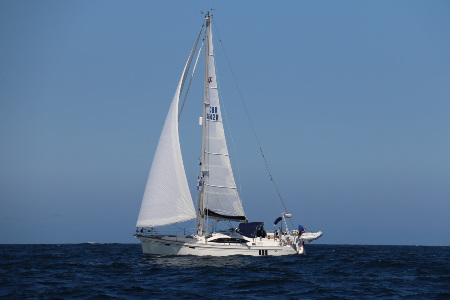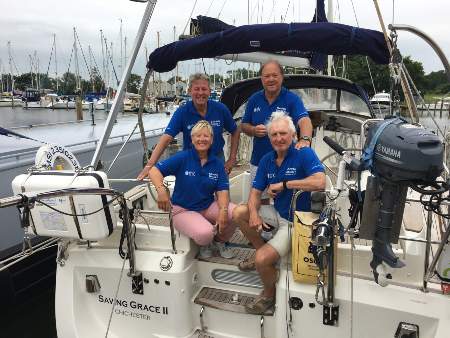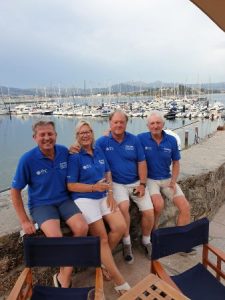UK: Navigating the COVID-19 Traffic Light System
Sailing back to the UK from Portugal in June was straightforward for Guy and Rhonda Taylor on board Saving Grace II – that is until they arrived home in the UK. The real challenge was navigating the bureacracy of the COVID-19 traffic light system!
Published 4 years ago
Navigating the upwind passage from Lagos on Portugal’s sunny Algarve to Chichester Harbour proved less challenging than the haphazard bureaucracy of our arrival in UK waters. Its COVID traffic light system reflecting the chameleon like nature of politics, rather than the practicalities for those enforcing or submitting to it. Yachts people especially.
Pre-departure Portugal was deemed green and good to go. In the blink of an eye the mandarins in Whitehall had then chosen orange (or amber), which then aligned with Spain (ironically the home of oranges), which made the plan easier. The intended non-stop passage from northern Portugal now became academic as returning from either resulted in 10 days self-isolation upon return to the UK.


- Getting ready to leave Lagos, Portugal.
We also embarked pre-departure on a fact-finding exercise with the broader sailing community and important stakeholders, such as the UK’s Royal Yachting Association (RYA). In order to protect the identities of the innocent, no names will be revealed, but huge applause to the government relations team at the RYA for trying to get the Home Office to consider practical means to receive yachts and their crews. Regretfully though, their stoic efforts have drawn little dividend.
We set off from Lagos and made a couple of stops along the Portuguese coast and Galicia, favourites including Cascais, Porto and Muros, then around Finisterre in deteriorating conditions. After a week waiting for a weather window in La Coruña to cross the Biscay, we had decided to avoid further border complications by by-passing France.


- Northerly winds across the Bay of Biscay made for an upwind passage but not huge seas.
Meanwhile our homework revealed five paperwork priorities.
- Clearing out of Spain – We made sure that we had our (UK) passports stamped out of Spain to prove our departure date from the EU. We didn’t have to do so between Portugal and Spain. The process was simple in La Coruña, involving a visit to the passport office in the port’s police station, 15 minutes’ walk from the Real Club Náutico marina.
- National Yachtline – Once back in UK waters we notified the National Yachtline (0300 123 2012), advising them about our yacht, crew and adherence to customs allowances. They also confirmed that they were unable to advise on matters associated with Border Force, other than repeating the COVID guidance text from the UK government website.
- Border Force – We aimed to comply with their guidelines, even though the whole process is designed around arriving passengers by commercial airline or ferry. This meant having a costly PCR test in Spain prior to departure, woefully out of date by the time we arrived in the UK, which really begs the question why? However, another box ticked.
- Passenger locator forms – Having spent no less than six days on passage in the bubble of our own boat (isolating in a very physical sense), it seems unfair that returning crews then need to enter a further 10 days quarantine upon arrival in the UK. Let’s face it, there’s no opportunity to compromise social distancing on the Biscay, with limited appeal in getting too close to shipping or lighthouse keepers around Ushant.
Once you have established an account via the UK government website, including a 14 digit password, you need to order your C19 test kits. Ordering the kit generates a reference number, without which you can’t complete the form.


- Saving Grace II at sea off Portugal.
Kits are available from various accredited labs and vary in cost. Apparently, when you’re in the UK, you could try dialing 119 for further assistance as none of the labs we rang – of which there were many – appear to pick up.
Another major frustration with this process in the UK is that being double vaccinated counted for absolutely nothing!
- Notice 8, form C1331 – Returning UK yachts need to report into the UK government by completing forms under the Notice 8 declaration, of which form C1331 was appropriate to our needs. This included details about the yacht, VAT status and crew lists. It also has to be printed out, signed and posted, yes posted!
Beyond the admin process, which actually is less onerous than it may appear, but more frustrating because of its one size fits all approach and minimal opportunity to seek clarification from a human being, the practicalities of returning were not over yet.
It appears that marinas have been instructed by Border Force not to allow returning crews to overnight on board as they are unable to use shared facilities, like loos and showers, or even visit the marina office or drop off rubbish in the bins.
Having spoken to one very reputable marina in Plymouth, they said that they were unwilling to impose this level of “depravity” on visitors, hence declined all yachts coming in from abroad. Ironic that the steps opposite this marina were the gateway to the New World 401 years ago; I wonder what those intrepid pilgrims would have made of the welcome they received in Massachusetts if it had been as haphazard as the one currently in force in the UK?
Having elected the non-stop route to Chichester Harbour, we called ahead to our home-to-be marina at Birdham Pool, to advise them of our arrival and compliance with the various rules. Being aware that we would be unable to spend the final night of our three-week passage on board in the marina, we secured a mooring buoy in Itchenor. (This meant that we didn’t go ashore and nor connected to it).

- Safely arrived at Birdham Pool Marina – Rhonda and Guy with crew members Peter and Taff.
By this point the rather dense sea-mist was lifting and the sun shone, revealing Chichester Harbour in all its glory. The passage from Portugal logged around 1,250 miles, mostly upwind, which offered a sense of accomplishment only matched by the achievement of dealing with the paperwork.
Guy and Rhonda Taylor
Saving Grace II
…………………………………………………………………………………………………………………………………..


- Guy and Rhonda with their crew members on the crossing.
About the Authors:
After a couple of years cruising in the UK and France on their yacht Saving Grace II (a Southerly 42RST ) Guy and Rhonda Taylor joined Rally Portugal in 2016. After a year keeping the boat in Lagos, they moved onto Spain and moored in Denia for three years, sailing around the Balearics.
Last year’s COVID-19 lockdown together with speculation about VAT issues, prompted the decision to return the boat to the UK. After over-wintering in Lagos, they made the boat ready in April and May and then set sail north on 6 June 2021.
The passage north was generally into the wind, but nothing particularly dramatic. Their route took them to Cascais and Porto (in Portugal), Baiona, Muros and La Coruna (NW Spain), across the Bay of Biscay and the English Channel into Chichester Harbour (UK).
…………………………………………………………………………………………………………………………………..
The opinions expressed in this article are the author’s own and do not reflect the view of Noonsite.com or World Cruising Club.
Related to following destinations: Portugal, Spain, United Kingdom
Related to the following Cruising Resources: COVID-19, Cruising Information, Documents, Documents Required
